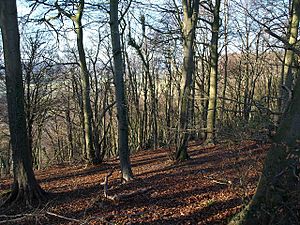Wotton Hill facts for kids
| Site of Special Scientific Interest | |

Westridge Wood (looking down scarp slope from the Cotswold Way)
|
|
| Area of Search | Gloucestershire |
|---|---|
| Coordinates | 51°38′47″N 2°21′28″W / 51.6465°N 2.35765°W |
| Interest | Biological/Geological |
| Area | 26.1 ha (64 acres) |
| Notification | 1954 |
Wotton Hill is a cool hill found on the edge of the Cotswold Hills in Gloucestershire, England. It's about 0.5 miles north of a town called Wotton-under-Edge. A famous walking path, the Cotswold Way, goes right over this hill.
This special area is a Site of Special Scientific Interest (SSSI). This means it's a protected place because of its amazing nature and geology. It covers about 26.1 hectares, which is like 64 football fields! It was first recognized as important in 1954.
Wotton Hill is part of the Cotswolds Area of Outstanding Natural Beauty. This area is looked after by the National Trust. The Gloucestershire Wildlife Trust also helps manage a part of it, called the Old London Road reserve.
Contents
Exploring Wotton Hill
Wotton Hill sits on Jurassic limestone rocks. It has different types of land, including woodlands, bushy areas (scrub), grassy fields, and old quarries. It's located to the west of another SSSI, Coombe Hill.
Ancient Woodlands
Two main ancient woodlands here are Westridge Wood and Conygre Wood. Most of the trees are beech trees. You can also find ash and pedunculate oak trees. Other trees include field maple and sometimes small-leaved lime.
Long ago, people used to manage these woods by coppicing. This means they would cut trees close to the ground to make them grow new shoots. Now, the woods are mostly tall forests with smaller plants growing underneath. These plants are typical for beech woods. You might spot nettle-leaved bellflower, goldenrod, and tutsan.
Rare Plants of the Woods
Wotton Hill is super important because it's one of only two places in the United Kingdom where you can find the very rare limestone woundwort. This special plant is carefully watched in the Old London Road reserve. It has also been seen in Westridge Wood and Conygre Wood.
Grasslands and Old Quarries
The woodlands are connected by open grassy areas and scrubland. The old, unused quarries also have scrub and grassland. These spots are perfect homes for butterflies! You can see beautiful butterflies like the chalkhill blue and brown argus here.
Amazing Geology of the Hill
Wotton Hill shows off some important rocks from the lower and middle Jurassic Periods. These are periods from millions of years ago! The lowest rocks are called the Cotswold Sand Formation. On top of that is a layer called the 'Cephalopod bed'. This bed is quite thick and has cool fossil ammonites, which are ancient sea creatures.
Above the 'Cephalopod bed' are other rock layers, including the 'scissum' beds and the lower Inferior Oolite. The very top layer is called Upper 'Trigonia' Grit. It's like looking at a history book made of stone!
Old London Road Reserve
This small reserve is about 0.22 hectares in size. It's on top of the Cotswold scarp, about 1.5 miles north of Wotton-under-Edge. The Gloucestershire Wildlife Trust bought it in 1972. Their main goal was to protect the rare limestone woundwort.
Special Plants
The limestone woundwort is a very important plant. It's protected by the 1981 Wildlife and Countryside Act. It was first found here in 1897 and was new to the United Kingdom. Another spot for it was later found in Denbighshire. This plant usually grows in mountains in central and southern Europe. It's also known as alpine woundwort.
When the reserve was bought, only a few limestone woundwort plants were left. Scientists helped by growing more plants from local seeds and putting them back into the reserve. In a good year, you can see many of its flowering spikes under the hedgerow.
Other Plants in the Reserve
The hedgerow (a line of bushes and trees) has many different woodland plants. These include wood anemone, bluebell, and ramsons (also called wood garlic). You can also find nettle-leaved bellflower and wood millet. The hedge itself is made up of plants like hawthorn, buckthorn, dogwood, hazel, ash, spindle, and traveller's-joy.
The open fields in the reserve are full of grassland flowers. Look for common fleabane, agrimony, cuckooflower, marjoram, and bulbous buttercup.
Insects and Birds
The hedgerow and fields are busy places for wildlife. Many butterflies live here, including the chalkhill blue and silver-washed fritillary. You can also spot different birds like the long-tailed tit, blackcap, and robin.
Protecting the Reserve
The main goal for this reserve is to help the limestone woundwort grow more. They keep plants like nettles under control so they don't take over. The hedgerow is also carefully managed, and the meadows are cut in June to help the flowers thrive.

